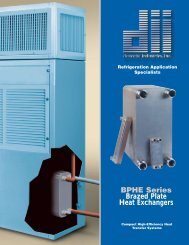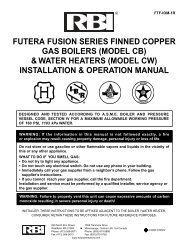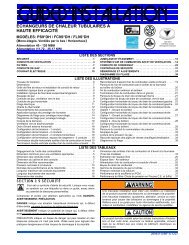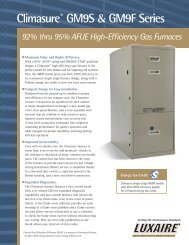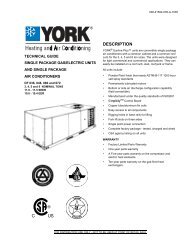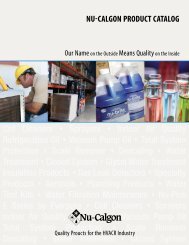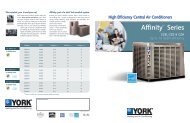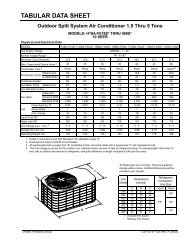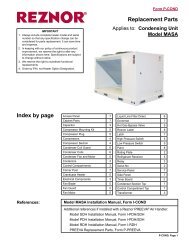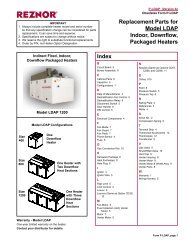Y-IM-Single Package AC and Single Package Gas/Electric Units ...
Y-IM-Single Package AC and Single Package Gas/Electric Units ...
Y-IM-Single Package AC and Single Package Gas/Electric Units ...
Create successful ePaper yourself
Turn your PDF publications into a flip-book with our unique Google optimized e-Paper software.
TABLE 49: GAS RATE CUBIC FEET PER HOUR<br />
Seconds<br />
Size of Test Dial<br />
for One<br />
Rev.<br />
1/2 cu. ft. 1 cu. ft.<br />
NOTE: To find the Btu input, multiply the number of cubic<br />
feet of gas consumed per hour by the Btu content of<br />
the gas in your particular locality (contact your gas<br />
company for this information as it varies widely from<br />
area to area).<br />
EXAMPLE:<br />
10 180 360<br />
12 150 300<br />
14 129 257<br />
16 113 225<br />
18 100 200<br />
20 90 180<br />
22 82 164<br />
24 75 150<br />
26 69 138<br />
28 64 129<br />
30 60 120<br />
32 56 113<br />
34 53 106<br />
36 50 100<br />
38 47 95<br />
40 45 90<br />
42 43 86<br />
44 41 82<br />
46 39 78<br />
48 37 75<br />
50 36 72<br />
52 35 69<br />
54 34 67<br />
56 32 64<br />
58 31 62<br />
60 30 60<br />
By actual measurement, it takes 19 seconds for the h<strong>and</strong> on<br />
a 1 cubic foot dial to make a revolution with a 192,000 Btuh<br />
furnace running. To determine rotations per minute, divide 60<br />
by 19 = 3.16. To calculate rotations per hour, multiply 3.16 •<br />
60 = 189.6. Multiply 189.6 • 1 (0.5 if using a 1/2 cubic foot<br />
dial) = 189.6. Multiply 189.6 • (the Btu rating of the gas). For<br />
this example, assume the gas has a Btu rating of 1050<br />
Btu/ft. 3 . The result of 199,000 Btuh is within 5% of the<br />
192,000 Btuh rating of the furnace.<br />
ADJUSTMENT OF TEMPERATURE RISE<br />
The temperature rise (the difference of temperature between<br />
the return air <strong>and</strong> the heated air from the furnace) must lie<br />
within the range shown on the CSA rating plate <strong>and</strong> the data<br />
in Table 19.<br />
After the temperature rise has been determined, the CFM can<br />
be calculated as follows:<br />
0.8<br />
CFM = Btu Input • ----------------------------<br />
( 1.08 ⋅ Δ°F)<br />
127083-Y<strong>IM</strong>-B-0606<br />
After about 20 minutes of operation, determine the furnace<br />
temperature rise. Take readings of both the return air <strong>and</strong> the<br />
heated air in the ducts (about 6 feet from the furnace) where<br />
they will not be affected by radiant heat. Increase the blower<br />
CFM to decrease the temperature rise; decrease the blower<br />
CFM to increase the rise (See ’SUPPLY AIR DRIVE<br />
ADJUSTMENT’).<br />
NOTE: Each gas heat exchanger size has a minimum<br />
allowable CFM. Below this CFM, the limit will open.<br />
BURNERS/ORIFICES INSPECTION/SERVICING<br />
Before checking or changing burners, pilot or orifices,<br />
CLOSE MAIN MANUAL SHUT-OFF VALVE AND SHUT OFF<br />
ALL POWER TO THE UNIT.<br />
1. Open the union fitting just upstream of the unit gas valve<br />
<strong>and</strong> downstream from the main manual shut-off valve in<br />
the gas supply line.<br />
2. Remove the screws holding each end of the manifold to<br />
the manifold supports.<br />
3. Disconnect wiring to the gas valves <strong>and</strong> spark igniter(s).<br />
Remove the manifold & gas valve assembly. Orifices can<br />
now be inspected <strong>and</strong>/or replaced.<br />
To service burners, complete step 4.<br />
4. Remove the heat shield on top of the manifold supports.<br />
Burners are now accessible for inspection <strong>and</strong>/or<br />
replacement.<br />
NOTE: Reverse the above procedure to replace the assemblies.<br />
Make sure that burners are level <strong>and</strong> seat at the rear of the<br />
gas orifice.<br />
1 - 6<br />
2 4 - 5 5 7 4 -<br />
6 ) 2<br />
0 1/ 0 9 / ) 5 ) , 7 5 6 - 6<br />
) 6 - + <br />
+ - + 6 4 5<br />
FIGURE 29 : TYPICAL GAS VALVE<br />
7 6 - 6<br />
2 4 - 5 5 7 4 -<br />
6 ) 2<br />
56 Unitary Products Group<br />
0 1<br />
<br />
8<br />
+<br />
0 1<br />
. .



